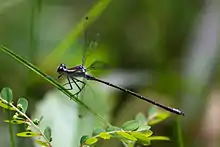Megapodagrionidae
The Megapodagrionidae are a family of damselflies,[2] commonly called flatwings for their habit of spreading out the hind wings horizontally when at rest.[3] They belong to the superfamily Calopterygoidea.[1]
| Megapodagrionidae | |
|---|---|
 | |
| Common flatwing (Austroargiolestes icteromelas: Argiolestinae) | |
| Scientific classification | |
| Kingdom: | Animalia |
| Phylum: | Arthropoda |
| Class: | Insecta |
| Order: | Odonata |
| Suborder: | Zygoptera |
| Superfamily: | Calopterygoidea |
| Family: | Megapodagrionidae Calvert, 1913[1] |
| Genera | |
|
3+ | |
The Megapodagrionidae are usually divided into five or six subfamilies:
- Argiolestinae
- Hypolestinae
- Megapodagrioninae
- Philosininae
- Pseudolestinae (often treated as distinct family)
Of these, the Argiolestinae are most diverse, while the Megapodagrioninae and (if placed here) Pseudolestinae are smallish. The others are very small or even monotypic.
In addition, two monotypic genera are sometimes placed here as monotypic subfamilies: Thaumatoneura is otherwise regarded as a monotypic family of the Calopterygoidea. Coryphagrion was usually also considered a monotypic family in older treatments; in recent times it is often included in the Pseudostigmatidae of the superfamily Coenagrionoidea. The extinct genus Electropodagrion was described from a fossil in Baltic amber in 2008 and placed into the family, with no subfamily designation.[4]
A 2013 phylogenetic analysis pares down this family into only three genera:[5]
- Allopodagrion
- Megapodagrion
- Teinopodagrion
References
| Wikimedia Commons has media related to Megapodagrionidae. |
| Wikispecies has information related to Megapodagrionidae. |
- Dijkstra, K.D.B.; et al. (2013). "The classification and diversity of dragonflies and damselflies (Odonata). In: Zhang, Z.-Q. (Ed.) Animal Biodiversity: An Outline of Higher-level Classification and Survey of Taxonomic Richness (Addenda 2013)". Zootaxa. 3703 (1): 36–45. doi:10.11646/zootaxa.3703.1.9. hdl:10072/61365.
- "Family MEGAPODAGRIONIDAE". Australian Faunal Directory. Australian Biological Resources Study. 2014. Retrieved 31 March 2017.
- Theischinger, Günther; Hawking, John (2006). The Complete Field Guide to Dragonflies of Australia. Collingwood, Victoria, Australia: CSIRO Publishing. p. 290. ISBN 978-0-64309-073-6.
- Azar, D.; Nel, A. (2008). "First Baltic amber megapodagrionid damselfly (Odonata: Zygoptera)". Annales de la Société Entomologique de France. New Series. 44 (4): 451–457. doi:10.1080/00379271.2008.10697580. – via Taylor & Francis (subscription required)
- Dijkstra, Klaas-Douwe B.; Kalkman, Vincent J.; Dow, Rory A.; Stokvis, Frank R.; Van Tol, JAN (2014). "Redefining the damselfly families: A comprehensive molecular phylogeny of Zygoptera (Odonata)". Systematic Entomology. 39: 68–96. doi:10.1111/syen.12035.